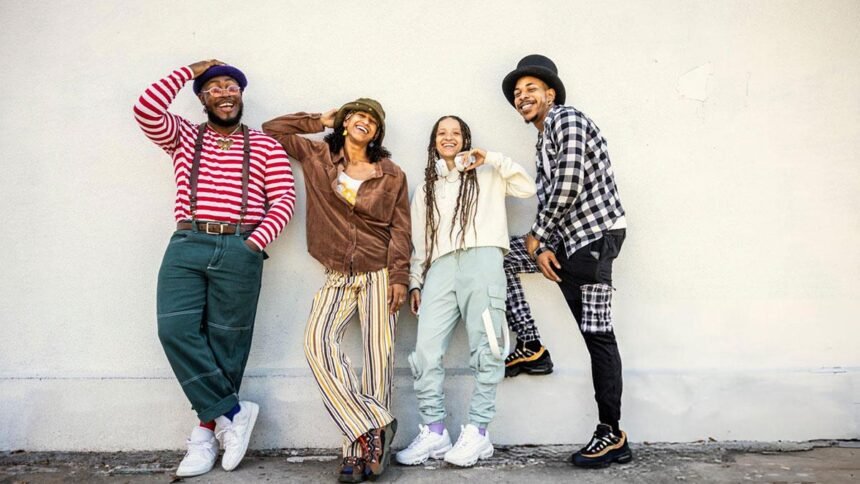Introduction: Why Streetwear Became More Than Clothing
Streetwear is no longer just casual fashion. It is culture. It represents music, art, community, and identity. From skateparks in Los Angeles to the streets of Tokyo, it has become the global language of self-expression. Streetwear thrives because it is practical, stylish, and accessible. But at the heart of every streetwear wardrobe are three essentials: the T-shirt, the hoodie, and the sneaker. These pieces define the look. They also shape the market, from high fashion runways to local street scenes.
This guide will take you through everything you need to know. You will learn what makes a T-shirt essential, why hoodies dominate the scene, and how sneakers drive the culture. The focus will stay on real details, not fluff.
Streetwear T-Shirts: The Foundation Piece
Fit
Streetwear T-shirts are oversized, boxy, or relaxed. The shape comes from the 1990s hip-hop and skate era. That era preferred clothes that moved freely and carried attitude. Today, the oversized fit still rules. A loose cut makes layering easy. It also creates a silhouette that feels casual but deliberate.
Fabric
The fabric is key. Heavyweight cotton, usually 200–250 GSM, gives structure. It makes the shirt drape better. It also lasts longer than thin cotton. For many fans, weight equals quality. Premium brands often highlight fabric weight to prove value.
Styles
- Logo T-Shirts: Supreme box logos are legendary. Palace and Off-White follow the same formula. A simple logo can turn a shirt into a status symbol.
- Graphic T-Shirts: Stüssy and BAPE built their names with bold graphics. Chinatown Market experiments with pop art visuals. Graphics keep T-shirts playful and artistic.
- Plain or Minimalist T-Shirts: Not every streetwear look needs graphics. Labels like Fear of God Essentials, Uniqlo U, and None of us keep it simple. These plain shirts act as base layers that balance louder pieces.
Purpose
The T-shirt is the entry-level streetwear item. It works as a blank canvas for expression. It layers well under hoodies and jackets. It can also stand alone as a bold statement piece. For newcomers, T-shirts are the most affordable way to enter the culture. For veterans, they remain timeless.
Streetwear Hoodies: The Uniform
Fit
Like T-shirts, hoodies in streetwear lean oversized. Dropped shoulders and boxy cuts dominate. The fit signals comfort and nonchalance. It creates a powerful yet casual presence.
Fabric
The best hoodies use heavyweight fleece or cotton blends. 400–500 GSM is common in premium lines. A heavier hoodie feels structured. It also keeps its shape after long use.
Styles
- Graphic Hoodies: The BAPE Shark Hoodie became iconic for its unique zip-up design. Travis Scott’s Nike collaborations sell out in minutes. Graphics give hoodies personality.
- Logo Hoodies: The Supreme box logo hoodie is a cultural artifact. So is the Represent Hoodie. Both show how a simple design can carry high value.
- Plain Hoodies: Black, grey, and muted tones have a place too. They act as everyday staples. Brands that specialize in premium blanks make plain hoodies a core item.
Features
Limited releases make hoodies desirable. Drops sell out in seconds. Scarcity drives resale prices. Many hoodies now cost two to three times retail on secondary markets. This cycle makes the hoodie a piece of fashion history as well as clothing.
Purpose
Hoodies symbolize streetwear culture. They balance comfort and status. They work with jeans, cargos, or even Vertabrae Sweatpants. For many, a hoodie is the first item they think of when they hear the word streetwear.
Sneakers: The Heart of Streetwear
Market Value
The global sneaker market is worth over $85 billion in 2025. Sneakers are not just shoes. They are the centerpiece of every outfit. They hold cultural meaning. They also drive resale markets more than any other item.
Key Features
- Sneakers connect to basketball, skateboarding, and hip-hop. These cultures built the foundation of streetwear.
- Collaborations create hype. A Nike x Off-White sneaker can sell for five times retail. Yeezy drops crash websites.
- Unlike most clothes, sneakers often increase in value. Rare pairs become collectibles.
Essential Types
- Classics: Nike Air Force 1, Adidas Superstar, and Converse Chuck 70 remain universal. These shoes never go out of style.
- Basketball Icons: The Air Jordan 1 and Nike Dunk shaped sneaker culture. They are still must-haves for collectors.
- Modern Collaborations: Yeezy 350, Nike x Off-White, and New Balance x Aimé Leon Dore push design boundaries. They dominate resale charts.
- Lifestyle Runners: Adidas Samba, New Balance 990, and Asics Gel-Kayano lead the lifestyle category. They are comfortable, versatile, and stylish.
Purpose
Sneakers act as status symbols. They anchor outfits. They also link fans to culture. A sneaker collection reflects taste, history, and identity. Many people build outfits around their shoes. In resale markets, sneakers are also investments.
How to Build a Streetwear Wardrobe
Step 1: Start with Basics
Begin with neutral T-shirts, plain hoodies, and versatile sneakers. These pieces are easy to wear daily. They also create a base for layering.
Step 2: Add Statement Pieces
After basics, add logo T-shirts, graphic hoodies, and collaboration sneakers. These items stand out. They add personality to simple fits.
Step 3: Maintain a Sneaker Rotation
Keep one classic sneaker, one retro sneaker, and one modern collab. This keeps outfits fresh. It also prepares you for different occasions.
Step 4: Mix Premium and Accessible
Pair a premium hoodie with an affordable T-shirt. Combine high-end sneakers with fast-fashion cargos. Mixing creates balance. A Represent Hoodie or rare sneaker looks even sharper when styled with simpler pieces.
Step 5: Use Layering
Layer T-shirts under hoodies. Wear hoodies under jackets. Combine textures and weights. Layering gives depth to outfits. It also keeps looks practical for different seasons.
Beyond the Essentials
Accessories
Caps, beanies, and messenger bags play supporting roles. They add personal flair. Jewelry, especially chains and rings, also cross over into streetwear.
Pants
Cargo pants, carpenter jeans, and wide-leg denim dominate. Slim fits are less common. Streetwear favors looser silhouettes. Sweatpants remain central, with high-quality options like Vertabrae Sweatpants blending comfort and style.
Outerwear
Varsity jackets, bomber jackets, and oversized puffer coats are common. These pieces elevate basics. They also make outfits stand out in colder seasons.
The Role of Limited Drops
Streetwear thrives on exclusivity. Brands release limited runs. Fans line up or wait online for drops. This scarcity builds community. It also drives secondary markets. Resellers play a major role in keeping demand high.
Sustainability and Streetwear
Sustainability is reshaping streetwear. Many brands now use organic cotton or recycled fabrics. Resale markets like StockX and Grailed also promote circular fashion. Buying secondhand reduces waste while keeping style intact. For future generations, sustainable streetwear is becoming the new standard.
Streetwear as Cultural Identity
Streetwear is more than clothes. It tells stories. A Supreme T-shirt links back to 1990s New York skate culture. A pair of Jordans carries basketball heritage. A hoodie can represent music, art, or activism. Streetwear reflects the streets it came from. It also connects global communities.
Conclusion: Essentials That Last
T-shirts, hoodies, and sneakers form the backbone of streetwear. They are simple, but they carry meaning. They balance comfort, culture, and style. A wardrobe built on these essentials never goes out of fashion.
Streetwear evolves every season, but the foundation stays the same. Whether you wear a plain T-shirt, a Represent Hoodie, or sneakers from a Nike collab, the essentials tell the story of culture and individuality. For many fans, streetwear is not about following trends. It is about creating them.









